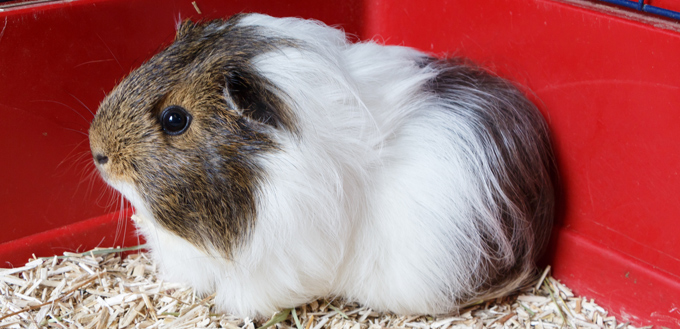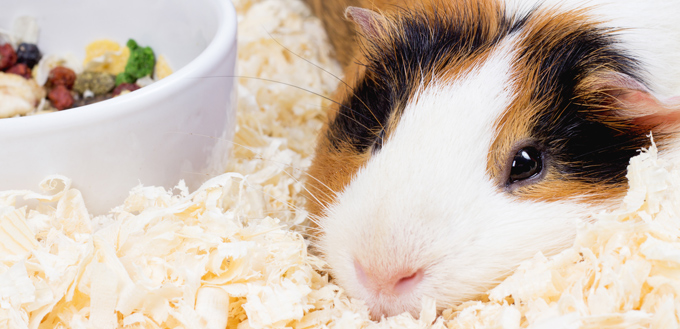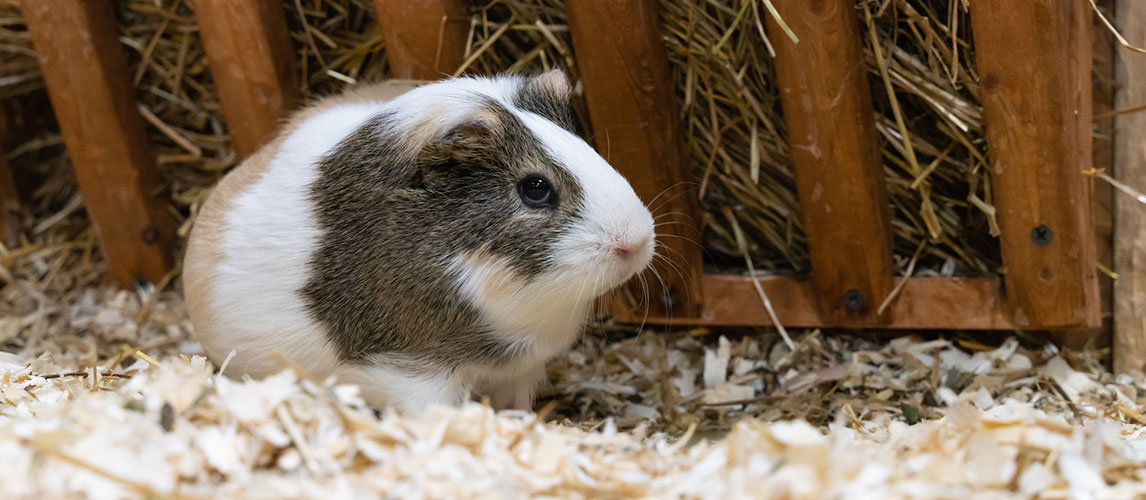Everyone deserves not only a nice place to live in, but also someplace safe and clean. And that includes your furry little friend, the Cavy. While most of us think so lowly of ‘rodents’ in general, these members of the ‘rat’ family deserve a home that is clean and hygienic so they don’t easily get sick and to allow them to live up to 10 years and maybe longer. You can check out the best guinea pig cage guide if you want to learn everything about a cavy’s home. But for now, let’s look at how you can clean your guinea pig’s home.

‘Resettle’ Your Cavy in a Temporary Shelter
Cleaning your cavy’s home starts with a good temporary shelter. You simply cannot go on cleaning its cage straight away with your furry (or skinny) pet still inside its cage. As such, you need to get another cage which can serve as your pet’s temporary home. It doesn’t have to be as large as its ‘permanent’ home, of course. What it needs is a temporary safe and secure place to stay while you go and clean its house.
That being said, it doesn’t have to be a cage. You can also use a box with high sides and an open top so your pet will not be able to escape easily while allowing ample ventilation. You can also punch holes on the sides of the box. Put something in the box that your pet can safely ‘chew’ on. They love to chew and this is their number one means of keeping their ever-growing teeth from reaching too great a length. If you have a deep dish pet cuddler with you – a type of dog or cat bed with high sides all around – you can use this, too. Whatever you use as your cavy’s temporary home, make sure that it is safe, secure, and comfy, too.
Clean Your Cavy’s Cage
Cavies are a bit skittish and they can get easily startled by loud noises. As such, it is wise to clean your cavy cage outside your house or away from its temporary home. It is also advisable to get all your cleaning materials ready so you’ll be more systematic in your cavy cage-cleaning chore. For this section, we’ve divided the cleaning of your guinea pig cage into light daily cleaning and weekly thorough sanitation. This is the only way to go to help make sure your pet’s abode stays relatively free from germs that can undermine its health and overall wellbeing.
Light Cleaning on a Daily Basis
Cleaning your cavy’s home every day is not really difficult. You only need to perform a quick inspection of the cage, paying special attention to dirty spots, stains, food debris, wastes, and others. If you’ve been giving your pet fresh vegetables and fruits as part of its diet, then you should discard these every day. Any other food that the cavy has left uneaten should also be discarded.
Check for waste materials like feces and bedding that has been soaked in urine. If its bedding is really soiled, then you have to replace it. Check the hay, too. If this is somehow ‘contaminated’ by your pet’s urine or feces or any other substance, then it should be replaced.
Get a paper towel and spritz some water on it. Use this to spot-clean the cage. We don’t recommend using a commercial pet-safe cleaner at this point since our purpose is only to lightly clean the cage.
Remove your pet’s water bottle and food container. Wash this in your kitchen sink using a solution of mild dishwashing agent and hot water. Make sure to rinse these items thoroughly. Dry them well, too. Refill your cavy’s hay, food pellets (if any), and water.
Deep Sanitizing on a Weekly Basis
If you are diligent enough in cleaning your guinea pig’s home every single day, then giving it a thorough clean come weekend should be a breeze. But here’s the thing. Just because you’ve been cleaning your pet’s home every day doesn’t mean you can already skip this part. Remember that daily cleaning involves light work only. Your weekly cleaning routine sanitizes the guinea pig’s home so it will not become a sickly cavy. You may want to potty train your cavy, too, if you want a more hygienic cage.
To clean the cage, you have to remove everything that can be removed. These can include food containers, water bottles, tunnels, cavy toys, and everything else. Items that can be washed should be washed and cleaned with hot soapy water. If your pet has a blanket, then make sure to wash it using only a mild detergent or one that is considered as safe for your pet. This will help kill microorganisms that may be present on the fabric. Just make sure to remove hay, food particles, droppings, or any other material on the fabric before washing.
Wear your plastic disposable gloves and remove the soiled bedding and hay as well as any dropping and litter. If there’s paper lining, you should remove this, too. We don’t recommend handling these items with your bare hands so it is best to wear gloves. Discard these into a garbage bag. Once you’ve picked up all the larger materials, it’s time to focus on the smaller ones. There will always be particles or debris that you cannot pick with your hands. You can use a small brush to ‘sweep’ these smaller particles and dust towards a small dustpan.
Prepare a solution of hot water and mild dishwashing liquid. Get a scrubbing pad or a sponge and dunk this in the hot soapy water. Now scrub both the inside and outside surfaces of the cage. Rinse well. Prepare another solution of 2 parts water and 1 part distilled white vinegar. Put this into a spray bottle and spray the surfaces of the cage. This should help kill germs without necessarily irritating the sensitive nose of your cavy. Rinse the cage thoroughly. If you can still smell a hint of vinegar, rinse it again until you can no longer smell the vinegar.
Dry the cage thoroughly. Ideally, it should be air-dried. But if this is not possible, then you should dry it with paper towel. What you want to achieve here is that you won’t feel any wetness on the entire surface of the cage when you run your fingers across the surface. Keep in mind that retained moisture is a magnet for mold and mildew. You don’t want this to happen.
‘Rebuild’ the Guinea Pig Home
If you’re 100% sure that the cage is completely dry, you can begin ‘rebuilding’ your cavy’s home. Start by putting its liner followed by its litter or bedding. Make sure that the bedding you put is safe for your pet, although ink-free paper is preferred. You may also want to try giving your pet fleece bedding. It’s comfy and can be especially absorbent. In the past, the go-to bedding for guinea pigs was wood shaving. Unfortunately, there’s now reason to believe that it may not be the best for cavies.
Now that you’ve got the ‘foundation’ for your pet’s home, it’s time to put the cavy ‘furniture’ in. Place the tunnels and toys as well as hideouts (if any) into the cage. Put its water bottle (make sure you replaced the water) and its food bowl. Put fresh guinea pig food pellets into its bowl while also hiding a few cavy treats in the cage. Don’t forget high-quality hay.

Groom Your Pet Before Putting it Back
You may have already cleaned and sanitized your cavy’s home, but there’s one more thing that needs to be done – give your pet a quick groom.
We don’t mean that you have to bathe it. A quick wipe of its body with an appropriate, unscented, chemical-free pet wipe should be enough. If you’re on a rather tight budget, you can use an ordinary washcloth and moisten it with clean water. Give your pet a nice rub, but be gentle. Make sure to wipe its coat and even its paw pads. Towel-dry your guinea pig afterwards. You don’t want it going back into its home damp.
It is important to realize that your cavy has been in its cage for a week before you had its home deeply cleaned and sanitized. This means there will be particles, dust, debris, and even droppings that may have attached to your pet’s fur. This is especially the case for the Peruvian or even the Abyssinian. Ideally, you’d want these furry babies to be combed or brushed every day so that they don’t get tangles on their hair. After all, a silky smooth long hair is the Peruvian’s best asset. Hair tangles can lead to mats which can cause a number of health problems for your little one such as skin irritation and infections.
Cleaning your guinea pig’s home is not difficult. Everyday cleaning is a must so you’ll have a much easier time during weekly deep-cleaning and sanitizing chores.
Sources:
- Pippa Elliott, MRCVS, How to Clean a Guinea Pig Cage, wikiHow
- Dr. Laurie Hess DVM, DABVP, Spring Cleaning Tips for Exotic Pets, Vetstreet
- Guinea Pig Housing, The Humane Society






